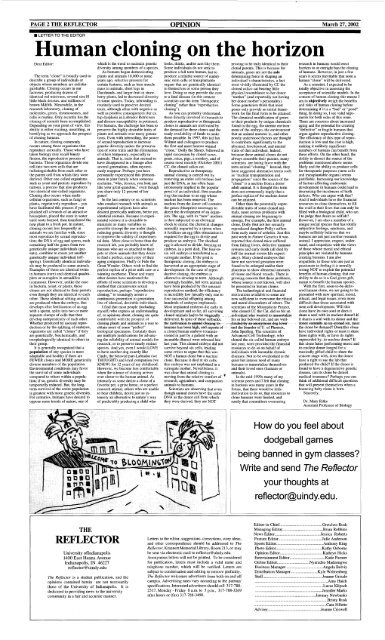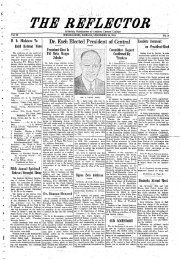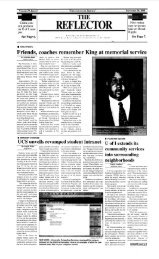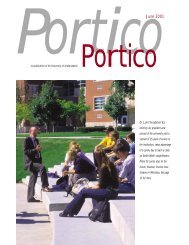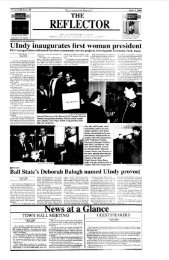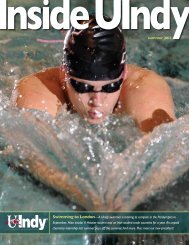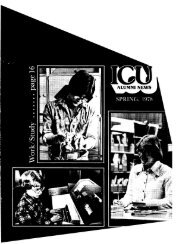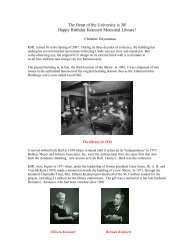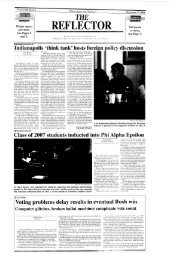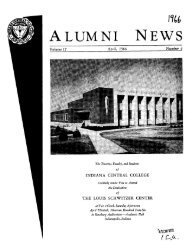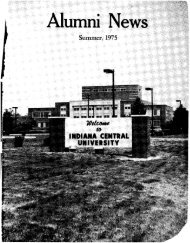the reflector - Frederick D. Hill Archives - University of Indianapolis
the reflector - Frederick D. Hill Archives - University of Indianapolis
the reflector - Frederick D. Hill Archives - University of Indianapolis
You also want an ePaper? Increase the reach of your titles
YUMPU automatically turns print PDFs into web optimized ePapers that Google loves.
PAGE 2 THE REFLECTOR INION March 27,2002<br />
H LETTER TO THE EDITOR<br />
Human cloning on <strong>the</strong> horizon<br />
Dear Editor:<br />
The term “clone” is broadly used to<br />
describe a group <strong>of</strong> individuals or<br />
objects whose members are indistin-<br />
guishable. Cloning occurs in our<br />
factories, producing dozens <strong>of</strong><br />
identical red minivans, several size10<br />
little black dresses, and millions <strong>of</strong><br />
brown M&Ms. Meanwhile, in <strong>the</strong><br />
research laboratory, cloning <strong>of</strong><br />
molecules, genes, chromosomes, and<br />
cells is routine. Only recently has <strong>the</strong><br />
cloning <strong>of</strong> animals been accomplished.<br />
Depending on your point <strong>of</strong> view, this<br />
ability is ei<strong>the</strong>r exciting, unsettling, or<br />
horrifying as we approach <strong>the</strong> prospect<br />
<strong>of</strong> cloning humans.<br />
In nature, cloning commonly<br />
occurs among those organisms that<br />
reproduce asexually. Those who have<br />
taken biology may recall binary<br />
fission, <strong>the</strong> reproductive process <strong>of</strong><br />
bacteria. These organisms divide one<br />
cell into two new cells that are<br />
indistinguishable from each o<strong>the</strong>r or<br />
<strong>the</strong> parent cell from which <strong>the</strong>y were<br />
derived. O<strong>the</strong>r one-celled organisms<br />
such as yeast and protists reproduce by<br />
mitosis, a process that also produces<br />
two identical one-celled organisms.<br />
Cloning also occurs when multi-<br />
cellular organisms, such as fungi or<br />
plants, vegetatively reproduce - you<br />
have facilitated this process if you<br />
plucked <strong>of</strong>f a branch <strong>of</strong> an attractive<br />
houseplant, placed <strong>the</strong> stem in water<br />
until roots formed, <strong>the</strong>n transferred <strong>the</strong><br />
new plant to a fresh pot. In nature,<br />
cloning occurs less frequently in<br />
animals we are familiar with, since<br />
most reproduce by sexual reproduc-<br />
tion; <strong>the</strong> DNA <strong>of</strong> egg and sperm, each<br />
containing half <strong>the</strong> genes from two<br />
genetically unique individuals (par-<br />
ents), combine to create yet ano<strong>the</strong>r<br />
genetically unique individual (<strong>of</strong>f-<br />
spring). Genetically identical individu-<br />
als may be produced in some animals.<br />
Examples <strong>of</strong> <strong>the</strong>se are identical twins<br />
in humans (rare) and identical quadru-<br />
plets or sextuplets in armadillos<br />
(common). However, unlike <strong>the</strong> case<br />
in bacteria, yeast, or plants, <strong>the</strong>se<br />
clones are not identical to <strong>the</strong>ir parents<br />
even though <strong>the</strong>y are identical to each<br />
o<strong>the</strong>r. These identical sibling animals<br />
are produced when <strong>the</strong> embryo, that<br />
develops after fertilization <strong>of</strong> an egg<br />
with a sperm, splits into two or more<br />
separate clumps <strong>of</strong> cells that <strong>the</strong>n<br />
develop independently <strong>of</strong> each o<strong>the</strong>r.<br />
Whe<strong>the</strong>r produced by asexual repro-<br />
duction or by <strong>the</strong> splitting <strong>of</strong> embryos,<br />
organisms are called “clones” if <strong>the</strong>y<br />
are genetically, biochemically, and<br />
morphologically identical to o<strong>the</strong>rs in<br />
<strong>the</strong>ir group.<br />
It is generally recognized that a<br />
population <strong>of</strong> any species is most<br />
adaptable and healthy if <strong>the</strong>re are<br />
FEWER clones and MORE genetically<br />
diverse members <strong>of</strong> <strong>the</strong> population.<br />
Environmental conditions may favor<br />
<strong>the</strong> survival <strong>of</strong> some individuals<br />
compared to o<strong>the</strong>rs within a popula-<br />
tion; if so, genetic diversity may be<br />
temporarily reduced. But, <strong>the</strong> long-<br />
term survival <strong>of</strong> <strong>the</strong> entire population<br />
is greatest with more genetic diversity.<br />
For centuries, humans have desired to<br />
oppose some trends <strong>of</strong> nature, one <strong>of</strong><br />
THE<br />
REFLECTOR<br />
<strong>University</strong> <strong>of</strong>lndianapolis<br />
1400 East Hanna Avenue<br />
<strong>Indianapolis</strong>, IN 46227<br />
<strong>reflector</strong> @ uindy.edu<br />
which is <strong>the</strong> trend to maintain genetic<br />
diversity among members <strong>of</strong> a species.<br />
As humans began domesticating<br />
plants and animals 10,000 or more<br />
years ago, selective pressure for<br />
certain features, such as lean muscle<br />
mass in animals, short legs in<br />
Dacshunds, and larger fruit in strawberry<br />
plants, led to decreased diversity<br />
in some species. Today, inbreeding is<br />
routinely used to preserve desired<br />
traits, although <strong>of</strong>ten with negative as<br />
well as positive consequences (for ex.<br />
hip dysplasia in Labrador Retrievers<br />
and disease susceptibility in potatoes).<br />
For humans, <strong>the</strong> challenge has been to<br />
preserve <strong>the</strong> highly desirable traits <strong>of</strong><br />
plants and animals over many generations.<br />
Even with inbreeding, <strong>the</strong> power<br />
<strong>of</strong> sexual reproduction to increase<br />
genetic diversity makes <strong>the</strong> preservation<br />
<strong>of</strong> some traits and <strong>the</strong> elimination<br />
<strong>of</strong> o<strong>the</strong>rs temporary, especially in<br />
animals. That is, traits that seemed to<br />
have disappeared in a lineage after<br />
several generations, <strong>of</strong>ten mysteriously<br />
reappear. Perhaps you have<br />
personally experienced this phenomenon<br />
in your family when someone<br />
exclaims, “why, Jessica, you look just<br />
like your great-grandma,’’ even though<br />
you share only 12 percent <strong>of</strong> her<br />
genes!<br />
In <strong>the</strong> last century or so, scientists<br />
who conduct research with animals as<br />
experimental subjects have also<br />
desired genetically uniform, better yet,<br />
identical animals. Because in experi-<br />
mental science it is desirable to<br />
minimize as many variables as<br />
possible (except <strong>the</strong> one under study),<br />
reducing genetic diversity is thought<br />
to improve <strong>the</strong> validity <strong>of</strong> experimen-<br />
tal data. More close to home than <strong>the</strong><br />
research lab, you probably know <strong>of</strong><br />
humans who are so attached to <strong>the</strong>ir<br />
pets or show animals that <strong>the</strong>y desire<br />
to find a perfect, exact copy <strong>of</strong> <strong>the</strong>ir<br />
aging companion, Fluffy or Fido <strong>the</strong><br />
Great Wonder. O<strong>the</strong>rs wish to find <strong>the</strong><br />
perfect replica <strong>of</strong> a prize milk cow or a<br />
winning racehorse. These and many<br />
o<strong>the</strong>r desires have motivated <strong>the</strong><br />
efforts <strong>of</strong> some scientists to develop a<br />
method that circumvents sexual<br />
reproduction, perhaps “reproductive<br />
cloning,” to seemingly assure a<br />
continuous generation to generation<br />
line <strong>of</strong> identical, desirable individuals.<br />
I find that most people (including<br />
myself) who express an understanding<br />
<strong>of</strong>, or opinions about, cloning are quite<br />
comfortable with <strong>the</strong> prospect <strong>of</strong><br />
cloning plants and animals as a way to<br />
obtain more <strong>of</strong> some “perfect”<br />
biological specimens. Certainly <strong>the</strong>re<br />
are multiple justifications for advanc-<br />
ing <strong>the</strong> reliability <strong>of</strong> animal models for<br />
research, or to preserve nearly extinct<br />
species. And yes, even I would LOVE<br />
to have ano<strong>the</strong>r dog exactly like<br />
Cindy, <strong>the</strong> beloved part-Labrador (we<br />
THOUGHT) and loyal companion (we<br />
KNEW) for 12 years <strong>of</strong> my childhood.<br />
However, we become less comfortable<br />
when <strong>the</strong> science <strong>of</strong> cloning arrives<br />
ever closer to <strong>the</strong> human animal. As<br />
intensely as some desire a clone <strong>of</strong> a<br />
favorite pet, a prize horse, or a perfect<br />
research animal, o<strong>the</strong>rs who are unable<br />
to bear children, desire just as in-<br />
tensely an alternative to nature’s way<br />
<strong>of</strong> predictably producing a child who<br />
The Reflector is a student publication, and <strong>the</strong><br />
opinions contained herein are not necessarily<br />
those <strong>of</strong> <strong>the</strong> <strong>University</strong> <strong>of</strong> <strong>Indianapolis</strong>. It is<br />
dedicated to providing news to <strong>the</strong> university<br />
community in a fair and accurate manner.<br />
looks, thinks, andor acts like <strong>the</strong>m.<br />
Some individuals do not seek to<br />
produce a full term human, but to<br />
produce a reliable source <strong>of</strong> embryonic<br />
stem cells or transplantable<br />
organs that are genetically identical<br />
to <strong>the</strong>mselves or some person <strong>the</strong>y<br />
love. Doing so may provide <strong>the</strong> cure<br />
to a fatal disease (in this context<br />
scientists use <strong>the</strong> term “<strong>the</strong>rapeutic<br />
cloning” ra<strong>the</strong>r than “reproductive<br />
cloning”).<br />
As you can probably understand,<br />
those directly involved in research to<br />
produce reproductive or <strong>the</strong>rapeutic<br />
clones in animals are motivated by<br />
<strong>the</strong> demand for <strong>the</strong>se clones and <strong>the</strong><br />
ready availability <strong>of</strong> funds to make<br />
<strong>the</strong>m possible. In 1997, this led Ian<br />
Wilmut and colleagues to produce<br />
<strong>the</strong> first and most famous animal<br />
“clone,” Dolly <strong>the</strong> Sheep, followed in<br />
rapid succession by cloned cows,<br />
goats, mice, pigs, a monkey, and <strong>of</strong><br />
course most recently (October 2001)<br />
CC, <strong>the</strong> cloned calico cat.<br />
Reproductive or <strong>the</strong>rapeutic<br />
animal cloning is carried out by<br />
removing an entire cell nucleus (not<br />
just <strong>the</strong> DNA, as has <strong>of</strong>ten been<br />
erroneously implied in <strong>the</strong> popular<br />
press) <strong>of</strong> an individual, <strong>the</strong>n transfer-<br />
ring that nucleus to an egg whose<br />
nucleus has been removed. The<br />
nucleus from <strong>the</strong> donor cell contains<br />
<strong>the</strong> genes (blueprint) necessary to<br />
direct <strong>the</strong> development <strong>of</strong> an organ-<br />
ism. The egg, with its “new” nucleus<br />
is <strong>the</strong>n subjected to an electrical<br />
shock to mimic <strong>the</strong> chemical changes<br />
normally imparted by a sperm when<br />
it fertilizes an egg (this stimulation is<br />
required for <strong>the</strong> egg to divide and<br />
produce an embryo). The shocked<br />
egg is allowed to divide, forming an<br />
embryo, in a petri dish. The four-to-<br />
six cell embryo is transferred to a<br />
surrogate mo<strong>the</strong>r. If <strong>the</strong> goal is<br />
<strong>the</strong>rapeutic cloning, <strong>the</strong> embryo is<br />
harvested at an appropriate stage <strong>of</strong><br />
development. In <strong>the</strong> case <strong>of</strong> repro-<br />
ductive cloning, <strong>the</strong> embryo is<br />
allowed to develop to term. Although<br />
seemingly healthy, full term animals<br />
have been produced by this unusual<br />
reproductive method, <strong>the</strong> efficiency<br />
is incredibly low (usually only one to<br />
four successful <strong>of</strong>fspring among<br />
hundreds <strong>of</strong> embryos implanted).<br />
Most implanted embryos die early in<br />
development and so far, all surviving<br />
cloned animals had to be surgigally<br />
delivered. In spite <strong>of</strong> <strong>the</strong>se setbacks.<br />
<strong>the</strong> motivation to ymmd<br />
humans has been high,<br />
a cloned human embryo (commis-<br />
sioned in part by a patient with an<br />
incurable illness) were released late<br />
last year. This cloned embryo did not<br />
survive beyond six cells, leading<br />
some critics to argue that this was<br />
NOT a human clone but a nuclear<br />
clone. Because it died at six cells,<br />
this embryo was not implanted in a<br />
surrogate mo<strong>the</strong>r. Never<strong>the</strong>less, it<br />
was clear that animal cloning is<br />
-<br />
moving from <strong>the</strong> relative comfort <strong>of</strong> *<br />
research, agriculture, and companion<br />
animals to humans.<br />
Scientists are observing that even<br />
though animal clones have <strong>the</strong> same<br />
DNA as <strong>the</strong> donor cell from which<br />
<strong>the</strong>y were derived, <strong>the</strong>y are NOT<br />
Letters to <strong>the</strong> editor, suggestions, corrections, story ideas,<br />
and o<strong>the</strong>r correspondence should be addressed to The<br />
Reflector, Krannert Memorial Library, Room 2 13, or may<br />
be sent via electronic mail to <strong>reflector</strong>@uindy.edu.<br />
Anonymous letters will not be printed. To be considered<br />
for publication, letters must include a valid name and<br />
telephone number, which will be verified. Letters are<br />
subject to condensation and editing to remove pr<strong>of</strong>anity.<br />
The Reflector welcomes advertisers from both on and <strong>of</strong>f<br />
campus. Advertising rates vary according to <strong>the</strong> patrons’<br />
specifications. Interested advertisers should call 3 17-788-<br />
2517, Monday - Friday 8 a.m. to 5 p.m., 317-788-3269<br />
after hours or (fax) 3 17-788-3490.<br />
proving to be truly identical to <strong>the</strong>ir<br />
clonal parents. This is because for<br />
animals, genes are not <strong>the</strong> sole<br />
determining force in shaping an<br />
individual’s characteristics, a fact<br />
most vividly illustrated by CC <strong>the</strong><br />
cloned calico cat bearing little<br />
physical resemblance to her donor<br />
“mo<strong>the</strong>r” (and reportedly not having<br />
her donor mo<strong>the</strong>r’s personality).<br />
Some geneticists think that most<br />
genes only provide an initial frame-<br />
work for <strong>the</strong> final form to be attained.<br />
The chemical modification <strong>of</strong> genes<br />
or <strong>the</strong>ir products by unique chemicals<br />
found in <strong>the</strong> egg, <strong>the</strong> uterine environ-<br />
ment <strong>of</strong> <strong>the</strong> embryo, <strong>the</strong> environment<br />
that an animal matures in, and o<strong>the</strong>r<br />
poorly understood factors are thought<br />
to contribute significantly to <strong>the</strong><br />
physical, biochemical, and mental<br />
traits <strong>of</strong> that individual. Indeed,<br />
because <strong>the</strong>se animal clones do not<br />
always resemble <strong>the</strong>ir parents, many<br />
scientists are losing favor with <strong>the</strong><br />
term animal “cloning.” Instead, <strong>the</strong>y<br />
have suggested alternative terms such<br />
as “nuclear transplantation and<br />
propagation” since <strong>the</strong> source <strong>of</strong> <strong>the</strong><br />
“clone” is a nucleus from a donor<br />
adult animal. It is thought this term<br />
does not erroneously imply that a<br />
perfect replica <strong>of</strong> <strong>the</strong> nucleus donor<br />
can be attained.<br />
O<strong>the</strong>r than <strong>the</strong> potentially unpre-<br />
dictable traits <strong>of</strong> some cloned ani-<br />
mals, more serious problems with<br />
animal cloning are beginning to<br />
emerge. For example, <strong>the</strong> first animal<br />
clone, Dolly (but not her sexually<br />
reproduced daughter Polly) suffers<br />
from early onset <strong>of</strong> arthritis. Just this<br />
past week in Nature Genetics it was<br />
reported that cloned mice suffered<br />
from failing livers, defective immune<br />
systems and early death (all died by<br />
half <strong>the</strong> normal mouse life expect-<br />
ancy). Many cloned embryos that<br />
have not survived gestation were<br />
found to be enlarged andor <strong>the</strong>ir<br />
placentas to show abnormal amounts<br />
<strong>of</strong> tissue and blood vessels. There is<br />
growing concern that <strong>the</strong>se problems,<br />
whose source is not known, will also<br />
be presented in human clones.<br />
The technological and financial<br />
motivations available to some are<br />
now sufficient to overcome <strong>the</strong> ethical<br />
and moral discomforts <strong>of</strong> o<strong>the</strong>rs. The<br />
scientists <strong>of</strong> <strong>the</strong> Missyplicity Project,<br />
who cloned CC <strong>the</strong> Cat, did so for an<br />
jndiyidual who wanted to imrtalize<br />
his or her beloved cat, and are well-<br />
.anonymous dog lover<br />
er <strong>of</strong> U. <strong>of</strong> Phoenix,<br />
John Sperling. The scientists <strong>of</strong><br />
Advanced Cell Technology, who<br />
cloned <strong>the</strong> six-celled human embryo<br />
last year, were provided <strong>the</strong> financial<br />
resources to do so on behalf <strong>of</strong><br />
individuals with incurable chronic<br />
diseases. Not to be overlooked is <strong>the</strong><br />
quiet but intense need <strong>of</strong> many<br />
humans to immortalize <strong>the</strong>mselves<br />
and <strong>the</strong>ir loved ones (humans or<br />
animals).<br />
In <strong>the</strong> mid- 1990s many <strong>of</strong> my<br />
scientist peers and I felt that cloning<br />
in humans was many years in <strong>the</strong><br />
future, that <strong>the</strong>re would be little<br />
motivation to do so, that resources to<br />
clone humans were limited, and<br />
surely that committees overseeing<br />
research in humans would erect<br />
barriers to or outright ban <strong>the</strong> cloning<br />
<strong>of</strong> humans. However, in just a few<br />
years it seems inevitable that soon a<br />
human “clone” will be delivered.<br />
As a scientist, I expected to be<br />
totally objective in assessing <strong>the</strong><br />
acceptance <strong>of</strong> scientific models. In <strong>the</strong><br />
context <strong>of</strong> human cloning this means I<br />
am to objectively weigh <strong>the</strong> benefits<br />
and risks <strong>of</strong> human cloning before<br />
determining if it is a “bad” or “good”<br />
thing. In doing so, I see valid arguments<br />
for both sides <strong>of</strong> this issue.<br />
There are concerns about increased<br />
aging and <strong>the</strong> potential for creating<br />
“defective” or fragile humans that<br />
argue against reproductive cloning.<br />
The efficiency <strong>of</strong> this type <strong>of</strong> reproduction<br />
is low and <strong>the</strong> cost is high,<br />
making it unlikely significant<br />
numbers <strong>of</strong> humans can benefit from<br />
<strong>the</strong>se efforts. On <strong>the</strong> o<strong>the</strong>r hand, <strong>the</strong><br />
ability to dissect <strong>the</strong> source <strong>of</strong> <strong>the</strong><br />
problems mentioned above seems<br />
likely and <strong>the</strong> ability to produce cells<br />
for <strong>the</strong>rapeutic purposes (stem cells<br />
and transplantable organs) seems<br />
justifiable. Increasing our knowledge<br />
<strong>of</strong> factors affecting embryonic<br />
development in humans could lead to<br />
decreasing <strong>the</strong> incidences <strong>of</strong> birth<br />
defects. Who can argue with that?<br />
And if individuals have <strong>the</strong> financial<br />
resources to clone <strong>the</strong>mselves, to fill<br />
<strong>the</strong> void in <strong>the</strong>ir lives that can only be<br />
filled with a biological child, who am<br />
I to judge that desire as selfish?<br />
However, I am also a member <strong>of</strong> a<br />
unique social species that has totally<br />
subjective feelings, emotions, and<br />
maybe selfishly believes that we<br />
humans are not just ano<strong>the</strong>r research<br />
animal. I appreciate, respect, understand,<br />
and empathize with <strong>the</strong> views<br />
<strong>of</strong> those whose moral and ethical<br />
principles are violated by humans<br />
creating humans. I am also<br />
empa<strong>the</strong>tic to those who are just as<br />
passionate in feeling it is morally<br />
wrong NOT to exploit <strong>the</strong> potential<br />
benefits <strong>of</strong> human cloning; that our<br />
ability to do so is a God given gift,<br />
meant to benefit <strong>the</strong> human species.<br />
With <strong>the</strong> first, soon-to-be-delivered<br />
human clone, we are going to be<br />
presented with new spiritual, moral,<br />
ethical, and legal issues, even more<br />
difficult than those associated with<br />
stem cell development. Will this<br />
clone have its own soul or does it<br />
share a soul with its nuclear donorldf<br />
it shares a soul with its donor and <strong>the</strong><br />
donoz d t e an un-atoned sin, must<br />
<strong>the</strong> clone be damned? Doeg this clone<br />
have individual rights or must it share<br />
those rights with, or have its rights<br />
superceded by, its nuclear donor? If<br />
this clone hates performing music and<br />
its nuclear donor longed for a<br />
musically gifted child to share <strong>the</strong><br />
concert stage with, does <strong>the</strong> donor<br />
have a right to sue <strong>the</strong> lab that<br />
produced <strong>the</strong> child? If <strong>the</strong> donor is<br />
found to have a degenerative genetic<br />
disease, can its clone be denied<br />
medical insurance? Perhaps you can<br />
think <strong>of</strong> additional difficult questions<br />
that will present <strong>the</strong>mselves when a<br />
bouncing baby clone is born.<br />
Sincerely,<br />
Dr. Mary Ritke<br />
Assistant Pr<strong>of</strong>essor <strong>of</strong> Biology<br />
How do you feel about<br />
dodgeball games<br />
being banned in gym classes?<br />
Write and send ?he Reflector<br />
your thoughts at<br />
<strong>reflector</strong>aui ndy.edu .<br />
Editor-in-Chief.. ....................................... Gretchen Rush<br />
Managing Editor ....................................... Brian Robbins<br />
News Editor ............................................ Jessica Roberts<br />
Feature Editor.. ........................................ Julie Anderson<br />
Sports Editor ............................................. Anthony King<br />
Photo Editor ............................................ Kathy Osborne<br />
Opinion Editor ......................................... Kathryn Hicks<br />
Entertainment Editor .................................. Katie Farmer<br />
Online Editor ............................... Nyaradzo Madzongwe<br />
Business Manager .................................... Angela Belviy<br />
Distribution Manager.. ........................ Kyle Wehrenberg<br />
Staff ......................................................... Joanne Grizzle<br />
...................................................................... Amy Haick<br />
................................................................. Lucas Klipsch<br />
................................................................ Jennifer Marks<br />
.......................................................... January Newbanks<br />
..................................................................... Bristy Rusk<br />
..................................................................... Cara Silletto<br />
Adviser.. ................................................. Jeanne Criswell


